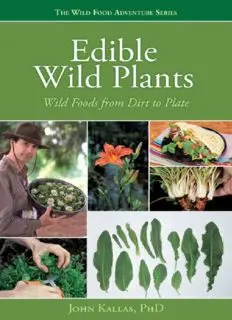
Edible wild plants: wild foods from dirt to plate PDF
Preview Edible wild plants: wild foods from dirt to plate
Edible Wild Plants Wild Foods from Dirt to Plate John Kallas, Ph.D. EDIBLE WILD PLANTS WILD FOODS FROM DIRT TO PLATE Digital Edition 1.0 Text © 2010 John Kallas, Ph.D. Photographs © 2010 John Kallas, unless otherwise noted All rights reserved. No part of this book may be reproduced by any means whatsoever without written permission from the publisher, except brief portions quoted for purpose of review. Gibbs Smith P.O. Box 667 Layton, Utah 84041 Orders: 1.800.835.4993 www.gibbs-smith.com ISBN: 978-1-4236-1659-7 To John Kardaras, my grandfather, who inspired me to learn, work hard, speak my mind, and challenge conventional thinking. He loved the outdoors and ate wild foods as a normal part of everyday life, just as I do today. There are a million things I wish I could ask him if he were still with us. Acknowledgments There are many people who have inspired and supported me over the years, and that support came in spite of the fact that I was pursuing a nonconventional field and career that few beyond myself took seriously. Dr. John Beaman, the former curator at the Michigan State University Herbarium, was a role model and enabler who gave a young upstart the resources, space, respect, and personal attention to seriously study the world of edible plants. Drs. Louis Twardzik and Louis Moncrief, the former Chairs of the Department of Park and Recreation Resources at Michigan State, both helped me on my path. It was Dr. Twardzik who encouraged me as young graduate student and provided me with the opportunity to teach wild foods at Michigan State—the start of my professional career. It was Dr Moncrief’s challenge for me to do something to genuinely advance the field of wild foods that led me to go on for an advanced degree in nutrition. Dr. Kathryn Kolasa opened my eyes to the importance of cultural foodways and how much people’s behaviors related to food can tell us about food, humans, and human ingenuity. It was Dr. Jenny Bond’s unconditional support that helped me complete my doctoral program with style. Access to land is an important factor in research and teaching about wild foods. I want to thank the grounds crew at Michigan State University, specifically the Beal Botanical Garden, for the unlimited access the staff has given me over the years; my longtime friends Shari and Daniel Raider, for the continuing access to their wonderful Sauvie Island Organics Farm; the Portland Parks Department and the folks at Portland Metro, for helping me actualize our shared mission of educating the public about the region’s amazing natural resources, particularly Jim Sjulin, for opening the door for me years ago; Leonard and Therese Tardif, whose swamp is one of my favorite teaching and research areas; my longtime friends Kevin and Deb Howard, whose land in the foothills of Mount Adams is generously offered each year; and all those countless others who have been so kind to offer their land all over North America to a fellow just trying to learn, teach, and make a difference. I want to thank Dawn Lesley-Carper, who purchased the first copy of this book several years before it was written in a sweet gesture of support. And my brother Dean, who has always been there if and when I needed him. For thirteen years, Dana Coffee has generously granted me use of the photograph of me holding the wild salad. That relatively candid photograph captured me doing what I love to do—teach. It has served me well over the years and has become my company logo. Thanks, Dana, for being that great photographer. My approach to the field of wild foods requires that I be a generalist. I observationally study plants in the field; read the botanical, historical, anthropological, nutrition, and food composition literature; interview practitioners; conduct processing and cooking experiments; and teach my findings to the general public. And while I can call upon my skills as a scientist when appropriate, my chosen role is now more of an investigative reporter for the general public. Other than when I have specific questions I am trying to answer, I do not have the time to steep myself in a more global understanding of nutrition research—which is vast and complex, filled with its own controversies. So I turned to my longtime friends and nutrition professionals Ginny Messina and Dr. Mark Messina, who gave me valuable input on the nutrition chapter. This book is better because of their comments and suggestions. And finally, I want to thank those who have provided me with places to live and work at prices I could afford. Longtime friends Kaj Gyr and Scott Bandoroff and, most recently, Donna Violette have been instrumental in making it possible for me to have this career and to write this book. Without their support, I would not be where I am today. Thank you all. Edible Wild Plants Table of Contents About the Author Disclaimer? Yeah, Right! Preface
